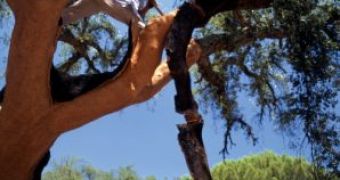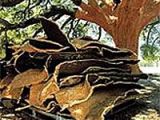Your strategy of "conquering" a girl includes a bottle of good wine or Champaign, but have you ever wondered where does the cork come from?
Cork is the product of an oak!
In some coasts of the Mediterranean Sea, like Spain, France, Italy, but also in the African coast (Algeria, Morocco and Tunisia) and outside (Portugal) real forests of cork oaks grow. This tree can grow up to 10-11 m (30-33 ft) tall (cultivated even to 20 m or 60 ft), while the trunk can reach widths of 2m (6 ft). The leaves are small and glossy on one side, on the other being almost white.
These are adaptations to the dry Mediterranean climate: both the transparent upper side and the hairs on the under side decrease water loss. Like in the case of other oaks, the fruit is an acorn. These acorns and those of the holm oaks are the secret of the famous Spanish black ham, as the pigs are fed with the acorns of the wild oaks. Cork oaks need a lot of light and some humidity, and, preferring sandy soils.
All the attempts of cultivating this species in other regions with similar climates (US, Brazil, Mexico and others) have failed. Currently, the main cork producer is Portugal, accounting for 50 % of the world production. The cork is in fact the collected bark of the tree.
The bark thickens with a rhythm of 2 mm annually and only when the tree has reached 20 years the first bark can be cropped. It is an easy but delicate operation, as during the extraction of the long plates, the worker must not touch the living layers of the trunk (phloem and wood vessels), otherwise the tree is killed.
Cork harvesting is done entirely without machinery, by ax! The first cork harvest from a tree is tough, with many cracks and can not be employed for making corks. But after the first shelling, the tree keeps growing cork, covering itself in 9-10 years with a new layer of cork, this time smooth and commercial.
In order to be used, the cork plates are left a few months to dry. A sole oak can give 12-15 crops, but after the age of 120-150 years, it is no longer exploitable. Cork is a natural durable product, very light and an excellent thermal and phonic isolator. And it never rots!
The largest forest of cork oak is Maamora, located north of Rabat (Morocco): 60,000 hectares. It is currently menaced by overgrazing exerted by 250,000 cattle and sheep.

 14 DAY TRIAL //
14 DAY TRIAL // 
